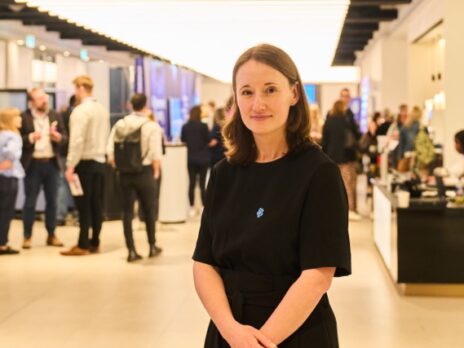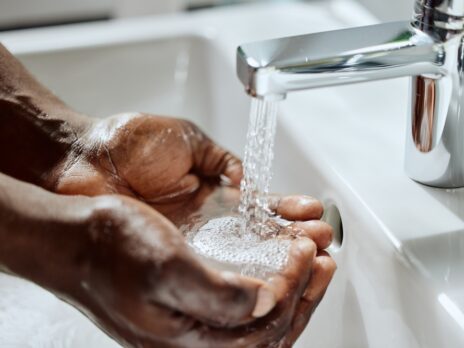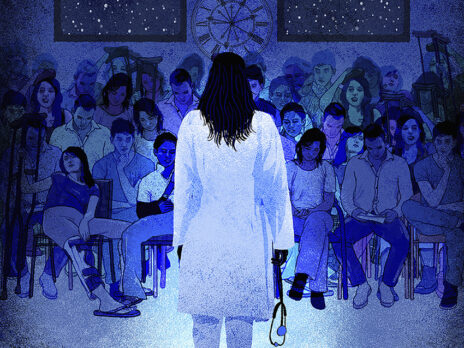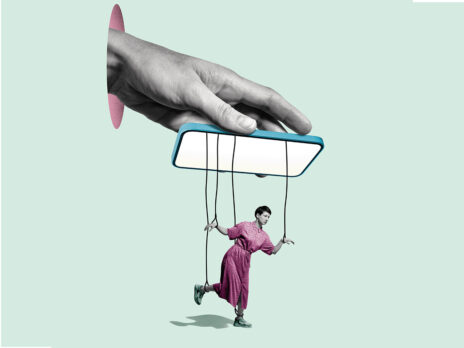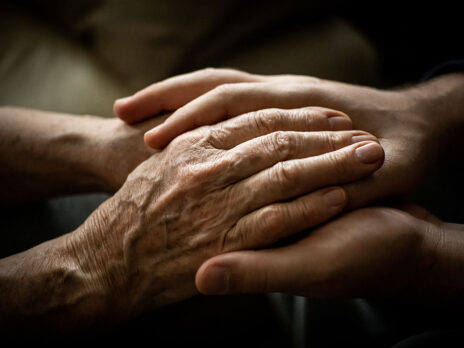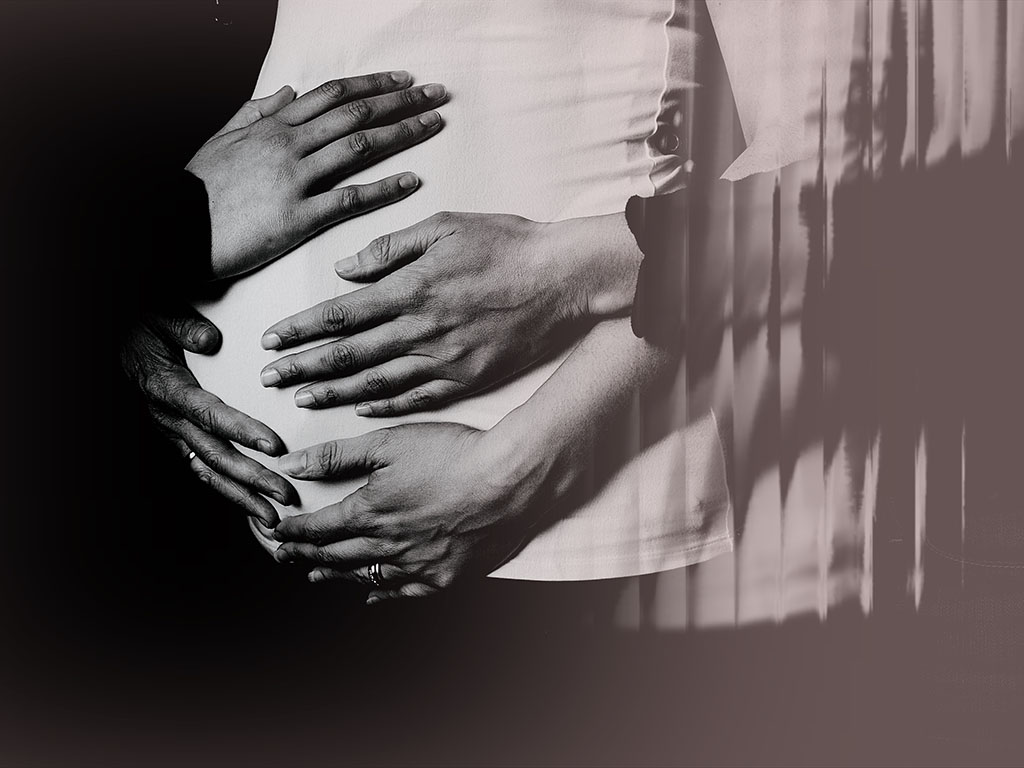
The midwife had warned me: second babies are born fast. You will need to get to hospital sooner than you think, she said, her kind brown eyes looking at me above a surgical mask. And when you get there, tell them your first baby came fast, too. She said it so many times I half-expected my second child to explode out of me.
When the day came, I headed to my local London hospital within three hours of the first contraction. Stumbling into maternity triage, I repeated the mantra: “It’s my second baby, the first came fast.” I wanted to go into a birthing pool, I said, but the woman on the other side of the glass muttered that this would not be possible. Barely looking up from her paperwork, she passed me a plastic vial and asked for a urine sample.
Time contorts during labour. My daughter was born only 45 minutes later, but before she emerged, slick and silent, into the water, there was an endless stretch of minutes. During that time the following happened: me managing to explain a urine sample was superfluous; my partner and I waiting in an empty room while two staff members – midwives? nurses? – discussed what to do with me; me being taken to a room with a pool; me ripping my clothes off and jumping into the water.
No one asked how I was, or when the contractions had started. While I laboured, impatient with the pain, something seemed off between the charge nurse and the midwife in attendance. They were short with each other. They ignored my pleas for help. When one asked the other whether my waters had broken, the response was an irritated, “I don’t know,” to which the other replied, “Well, then ask her!”
After the birth they were kind enough. But before that, it was as if they didn’t see me.
This lack of kindness, the tensions, were more than mere over-sensitivity or bad luck. Like our schools, closed at the last minute before the start of term because of years of poor maintenance, like our councils declaring financial distress, here was yet another symptom of crumbling Britain: a maternity service stretched perilously to breaking point.
Polling shows that experiences like mine are not unique. In January a survey by the Care Quality Commission (CQC), England’s independent healthcare regulator, found a “concerning decline” in women receiving the help they needed during and after birth over the past five years. In May 23 per cent of new mothers surveyed by the Times and Mumsnet said they thought “they or their baby had been put in danger because of the standard of care they received”; over a fifth said they had been treated in a way that was “not kind or caring”. In July an Observer analysis of CQC data found that nearly half of 45 NHS hospital maternity services were substandard.
These failings echo the wider NHS crisis; the legacy of austerity, a crumbling infrastructure and staff shortages have taken their toll. But maternity services are also unique when it comes to healthcare: pregnancy and birth are physiological processes, not ailments. And while sometimes complex and medical, requiring emergency care, they are a known demand we should be able to support and plan for.
According to estimates by the Health and Social Care Committee, maternity services are underfunded to the tune of £200m to £350m, though the government has announced various funding initiatives. Recent analysis by the Times found that 60 per cent of the total cost of harm for clinical negligence – meaning the value of the estimated cost of claims received by the NHS or expected for incidents that have occurred – (including incidents that have caused cerebral palsy and brain damage) was related to maternity services, to the tune of £8.2bn. Meanwhile, last year there was an 8 per cent drop in applications for midwifery and nursing courses.
[See also: There will be blood]
The consequences of low investment and under-staffing are being felt across the country. Some hospitals have stopped providing Entonox, or gas and air, a safe pain relief used by 76 per cent of women who gave birth in 2022, because prolonged exposure poses a health risk for midwives. Hospitals are not adequately ventilated for its use. Last year, four in ten maternity units temporarily closed because of a lack of staff. In July, Rishi Sunak announced measures to increase the number of midwives, as part of the overdue NHS Long-term Workforce Plan – but the plan still predicted a shortfall of 6-18 per cent by 2036. “This government is knowingly breaking the maternity service,” tweeted the midwife and author Leah Hazard. “The plan is smoke and mirrors.”
“Moral distress” or “moral injury” – technical terms for the unease engendered by the gap between the job a clinician wants to do, and what they can deliver – is on the rise among midwives and obstetricians. Burnout is chipping away at their empathy.
These are issues that predate the pandemic, when Covid restrictions upended maternity services world-wide. In April, a Women and Equalities Committee report highlighted stark racial disparities in maternal mortality rates in the UK, which are almost four times higher for black than white women. This disparity has been documented for at least 20 years, but the rate has hardly budged.
And over the past two decades, at the Shrewsbury and Telford Hospital NHS Trust, at Morecambe Bay, at East Kent, at Nottingham it seems, too, hundreds of babies and mothers have died or suffered permanent harm in avoidable circumstances. Official reviews have identified similar systemic failures: poor relationships between obstetricians and midwives, weak leadership, failures of care and compassion, dangerous staff shortages, and a tendency not to learn from mistakes – problems that have been alleged, too, in analyses of the failure to detect and stop the serial murders committed by Lucy Letby on an NHS neonatal ward.
But alongside these failings, the reviews seemed to indicate another factor: a culture of midwives promoting “natural” or non-medical childbirth that put patients in danger.
Britain’s maternity policy is considered one of the most progressive in the world. It places an emphasis on informed choice: on paper, women can choose exactly how and where they give birth. They can, in theory, request to labour in any position they like, with an epidural to numb the pain, or via caesarean section. If their pregnancy is deemed low risk, they can labour guided by a midwife in a less interventionist “birth centre”, replete with a pool and balls to rest on, or at home. They can specify whether they want the vernix – a white, creamy biofilm that covers a foetus in the womb – left on or washed off their baby before holding them for the first time.
This prioritisation of choice (also known as “woman-centred care”), a shifting of power from the institution to the individual, has, over time, transformed maternity units. It has required the expansion of birth centres, midwifery-led care and home birth services. Rates of delivery in midwife-led birth centres are far higher in England (11 per cent in 2018) than in other developed countries where this choice is available (0.52 per cent in the US, 0.6 per cent in Ireland). Around 2 per cent of births in England and Wales happen at home, too, more than most developed countries. In some European states, including Czech Republic and Slovakia, home births are not illegal, but midwives face penalties for practising outside hospital, including temporary bans from the profession.
Britain is progressive, too, because seeking women’s input is official NHS policy. In 2016, its Better Births review called for all NHS trusts in England to embed Maternity Voices Partnerships (local grassroot groups) so that people using the service could actively shape it. But in the face of the current crisis, is this principle of personalised care an illusion?
When Lesley Page, the former president of the Royal College of Midwives, qualified in 1966, there was little consideration of what mothers wanted. “The women’s movement hadn’t really affected the status of women around childbirth,” she told me during a recent phone call. “We certainly wouldn’t have been thinking about women having control and making decisions about their care.”
After the National Health Service was founded in 1948, the government set targets for hospital births – 70 per cent of live births in 1959, and 100 per cent in 1967 – because conditions there were considered safer than the average home. In 1963 almost a third of women gave birth at home in England and Wales; a decade late it was fewer than one in 20.
Page worked on home and hospital births. The community midwifery services, as dramatised in the BBC’s Call the Midwife, were medicalised but “very calm… very relaxing. It was very beautiful, actually.” In hospitals, meanwhile, women were processed for delivery, with pupil midwives like Page called to attend impending births by flashing lights. There weren’t many interventions then – no ultrasounds, no foetal monitoring – but Page compared it to “a factory system”.
By the 1980s hospital birth had become more medicalised. Soo Downe, now a professor of midwifery at the University of Central Lancashire, qualified in 1985 and recalled regular inductions (medical interventions to speed up contractions). The rate of induction had peaked in the mid-1970s, with around 41 per cent of births induced. (Today’s rates are slightly lower, at 34 per cent.) In the 1980s women were fitted with vaginal catheters to measure the pressure of the uterus, straps around their abdomen to measure contractions, and had drips going into their arms. When a woman was ready to give birth, she would, in Downe’s words, be “hauled” to the labour room on a trolley and then “hauled” onto a high narrow bed, often with her legs in stirrups, or widely apart, feet against the midwives’ hips, and then urged to “hold your breath and push, push, push!”. Looking back, she finds this shocking.
That decade these practices met opposition. One dominant figure was Sheila Kitzinger, the anthropologist and childbirth campaigner. The term “natural birth” had originated in the 1930s with the British obstetrician Grantly Dick-Read, who believed women should labour without interventions, not even pain relief, in case they upended “normal” physiological processes. But Kitzinger fought for maternity services to follow the wishes of individual women; they should be able to access the interventions they wanted, and not be medicalised by default. A pioneer of the birth plan, she defended this innovation against criticism that it created unrealistic expectations; a birth plan was no more idealistic than packing for a picnic without knowing the weather, she argued.
In 1992 the Health Select Committee commissioned the Winterton Report, which concluded that it was “no longer acceptable” to have medicalised maternity care as the norm when there was not enough evidence that it was preferable, or safer. In response the government published its own review, Changing Childbirth, in 1993, and adopted its findings as official policy: an explicit shift that focused maternity care around a woman’s right to choose. This was no less than “a revolution”, Page wrote in her Oxford Dictionary of National Biography entry on Kitzinger, who was a close friend.
[See also: “Women should be in every place decisions are made”]
Yet today those gains are at risk. And in the face of unthinkable loss – what could be worse than the death of a baby, or of a newborn’s mother? – the search for blame has pitted “natural” against “medical” birth. An argument over ideology, and the perception of the damage it poses, has flourished in a defunded system, amid divisive media coverage and the polarities of the internet.
“It has been seen as a culture war,” Page said when I asked if this was the case. “It’s very sad for that to happen, and where it does we must come together, because we have the potential of that [progressive] policy. Pitting ‘natural’ against ‘medical’ birth leaves out the rapid and unexpected changes that can happen around childbirth, where there is often a need to make decisions and act swiftly. It is important to find common ground.”
She adds a caveat: the roots of this polarisation lie in human loss, not ideology. “The debate has occurred because of tragedies within the NHS.”
When Donna Ockenden began her review of Shrewsbury and Telford maternity services in the summer of 2017, she started with 23 cases. By March 2022, when she published her final report, that number had risen to nearly 1,500, most of which happened between 2000 and 2019. Ockenden concluded that 201 babies and nine mothers had died avoidable deaths. Dozens more had suffered permanent damage.
In response the trust, which serves half a million people in the West Midlands, offered “wholehearted apologies for the pain and distress” caused. It had already begun to make changes, its chief executive Louise Barnett said: 86 per cent of Ockenden’s 52 recommendations (published in a 2020 interim report) had been implemented, including hiring more staff.
Strikingly, several of these recommendations focused on the dangers posed by midwife-led “natural” birth. The review concluded, for instance, that continuity of care – the principle that a woman be seen by the same midwifery team where possible throughout her pregnancy – should be discontinued because it was unsafe under current staffing levels. It also found a caesarean-adverse culture: the trust’s rates were among the lowest in the country. “A typical quote during interviews [with patients],” Ockenden wrote, “was that, ‘They didn’t like to do caesarean sections’.”
Such findings have fuelled the division over “natural” or assisted birth. In 2020, after Ockenden’s interim report, Jeremy Hunt, then chairman of the Health and Social Care Committee, asked Nadine Dorries, the patient safety minister, whether it was “time to stamp out the ‘normal birth’ ideology, which says that there can be a debate, or compromise about the total importance of a baby’s safety”.
Last year bereaved parents wrote to Dame Ruth May, the chief nursing officer for England, to protest against the University of Central Lancashire’s 20-year-old International Normal Labour and Birth Research Conference (Soo Downe is one of the founders), which was taking place near Furness General Hospital. The parents noted that a key theme of the 2015 Kirkup Review into failures there had been the “over-zealous pursuit of the natural childbirth approach” by a small group of “dominant individuals”; at times, the investigation said, this led to “inappropriate and unsafe care”.
Terms such as “normal” or “natural” birth can be divisive themselves, passing implicit judgement on those who need – or want – medical intervention. The bereaved parents wrote that “the language and focus” of the conference had caused “a high degree of distress and trauma”. The University of Central Lancashire changed the name of the 2022 event to the “International Labour and Birth Research Conference”. In an email, Downe told me the conference was not a campaigning event for “normal birth at all costs”, but aimed to share the latest research on safe “spontaneous” labour (now the preferred, more neutral, term).
Meanwhile Britain’s battle over birth has caught the attention of overseas clinicians. In July 2022 Ank de Jonge, a Dutch professor of midwifery, Raymond de Vries, a professor at the University of Michigan, and Eugene Declercq, a professor at Boston University, published an article warning that the Ockenden review could damage the UK’s progressive approach to maternity care. One issue they looked at was Shrewsbury and Telford’s low caesarean rate compared to the rest of England (between 8 and 12 per cent against a national average of 24 to 29 per cent).
Caesareans are always a “trade-off”, De Jonge et al wrote, citing research suggesting that they are linked to higher rates of stillbirth in second pregnancies. They also noted that places with higher C-section rates have marginally “higher rates of perinatal deaths on average”. And between 2010 and 2020, the UK had one of the highest increases in C-section rates among developed countries. Ockenden’s recommendations, and the subsequent media coverage, they concluded, “may, in fact, aggravate the very problems they are meant to allay”. Then they reached for an insensitive metaphor: “Why throw out the baby of personal care with the bathwater of mismanagement?”
The natural birth discourse has been a “polarising distraction” from the problems in maternity services, said the midwife Leah Hazard, likening the current crisis to “death by a thousand cuts”. Hazard, who is based in Scotland, came to midwifery ten years ago as a second career after becoming a parent. Now, she would hesitate to recommend the profession to anyone. “What used to be considered an unusually busy or stressful day is every day. I don’t know if this is a sustainable career for me any more.”
Over the past decade, Hazard said she had witnessed a steady decline, apart from a brief surge of morale during the pandemic. Beneath this neglect lies an undervaluing of maternity services, she believes; they are not seen as acute or front-line, like A&E. “[There’s] a deep patriarchal undervaluing of the whole process of pregnancy and childbirth,” she said. “Not only because it’s for women, but also because it’s predominantly provided by women.”
She detects “a streak of misogyny” in the way midwives are portrayed when things go wrong. She remembers reading a news article about midwives before starting a 12-hour shift, and seeing beneath it a reader’s comment that described them as “cruel, twisted gatekeepers”.
It is hard to uphold the principle of women-centred care in such circumstances. When you are time-poor and understaffed, it might be easier to induce a labour than to wait. How do you give every patient what they want, when a long line of women is waiting for that bed?
A week after Ockenden published her final review of Shrewsbury and Telford Trust last year, families in Nottingham started asking her to look into alleged failures there, too. The process of gathering evidence for that review has highlighted the links between the stubborn racial disparities in maternal deaths and the systemic problems uncovered by reports into other trusts. In a letter to Anthony May, chief executive of Nottingham University Hospitals NHS Trust, Ockenden wrote that black and Asian families have a “deepened mistrust” of the service. Muslim women had complained that they were dismissed when they raised concerns about being assigned a male sonographer. One woman had been forced to phone her mother in Pakistan for Urdu translation when she needed an emergency C-section.
There have already been several initiatives to deal with racial disparities, including a 2022 government task force, said Tracey Bignall, senior policy and practice officer at the Race Equality Foundation. The 2019 NHS long-term plan, for instance, had a commitment that 75 per cent of black and ethnic minority women, and those from deprived backgrounds, would have continuity of care by 2024. But this target isn’t mentioned much now, said Bignall: “The cynic in me thinks this is because of workforce difficulties.” The NHS’s three-year plan for maternity and neonatal services, published in March this year, noted particularly poor maternity care experienced by families from ethnic minorities, but omitted a hard target.
The women who Bignall speaks to about their experiences of maternity care tell her the same things: they feel stereotyped, and that often staff don’t know how to treat them. Jaundice, common among newborn babies, causes yellowing of the skin and eyes, for instance. It is harder to detect in dark skin, and clinicians are not always aware of the difference. Many women report not being believed by hospital staff when they say they are in pain, or that something is wrong. Poverty and access to care are also a factor. Women living in the most deprived parts of the country are 2.5 times more likely to die in childbirth.
My daughter was born healthy and perfect. We were fine, and for weeks I couldn’t stop questioning my unease about the birth. I was spoiled, perhaps, expecting to feel held, my every whim catered to, by overworked and underpaid staff.
In June, just over two years after my daughter was born, I returned to the maternity unit as a volunteer breastfeeding supporter. The first time, my stomach tightened at the memory of my labour, nervous I would see the staff I had officially complained about only weeks after the birth. Each conversation with a mother holding her baby filled me with emotion, my body replaying the highs and lows of the birth like a deep physical memory.
I go at night, when the corridors tend to be quiet. Inside the rooms are new families, hidden by grey curtains. Sometimes I see women rocking babies through the doorways. There is a calm, even though the babies cry. The midwives make their way around the ward, carrying out assessments. How is the mother feeling? How is the baby feeding? Are they pale? I hear them aim for reassurance with soft voices.
The ward is decorated with good intentions: posters with advice on holding your baby close to stimulate oxytocin, the “love hormone”; appeals to families to share feedback; a friendly notice to maintain the ward’s restful hush. The reception desk is lined with thank you cards.
Many women have had births more traumatic than mine. But the more I thought about it, the more I realised how lucky we were that everything had turned out all right. It was my second delivery, we told each other: just imagine how bad it might have been were it my first. There is a fine line between a difficult and a dangerous birth, particularly when a woman is frightened, or anxious, ignored – or worse.
In the arguments over the funding of maternity services, in the cycle of reports and recriminations, and in the ideological divisions over the “right” way to give birth, this is what gets lost: an understanding of how profound and foundational an experience it is. “Maternity care has an impact on the life course, not only of the baby, but of the woman, and on future generations, too,” Page said.
Thirty years ago, when power in maternity care moved from the institution to the individual, that shift was radical, progressive and revolutionary. It was about women’s rights and politics, as much as it was about health. But today the system is so stretched that the nexus of power is nowhere. It is not with clinical staff, nor with families. Instead, we muddle through. We hope for the best. We and our babies will live, probably.
[See also: Pregnant Then Screwed’s Joeli Brearly: “I think motherhood radicalises you”]
This article was amended on 5th October to correct the figure for the total cost of harm caused by clinical negligence in maternity services
